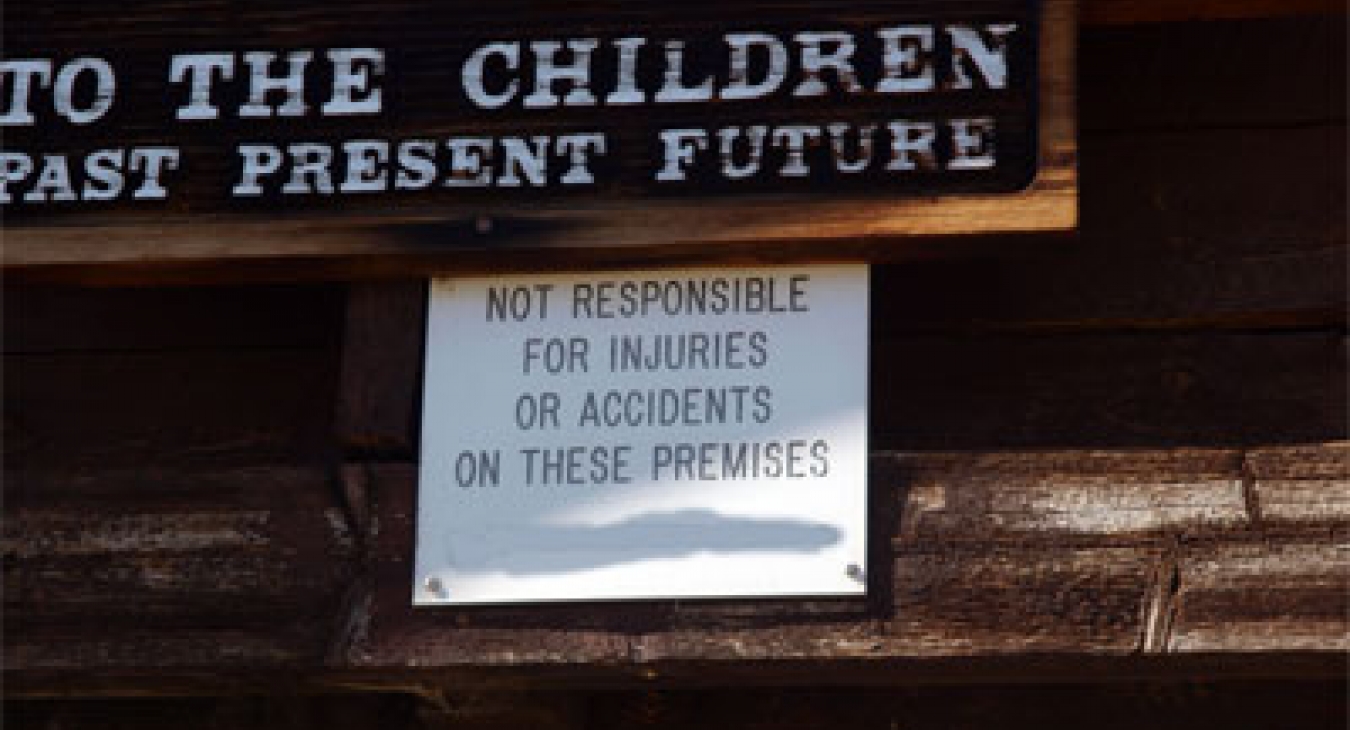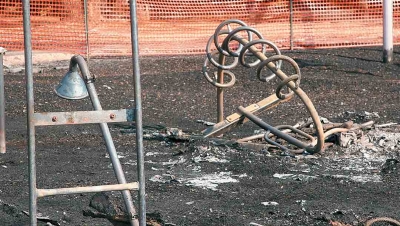Hazard versus Risk versus Injury Outcome Part 1 of 2
In my last column I said I was going to write about how to bring more challenge and risk into the play area without creating a hazardous condition. I talked about the need for challenge and risk and why it seems to be disappearing from our public playgrounds. I have decided to hold that topic for a bit since something has come up of more importance.
I just returned from ASTM International (ASTM) May Committee Week in Indianapolis. Your ASTM F15.29 Subcommittee responsible for the ASTM F1487 Standard for public play equipment held several meetings along with hundreds of other ASTM Committees and Subcommittees. The first day we discussed two very interesting and timely topics related to the current discussions taking place internationally on the importance of both risk in playgrounds and the impacts safety standards have on playground environments. This topic is becoming the “Ying and Yang of Child Development.” We continue to discuss the negative impacts the lack of risk, challenge, and free play opportunities have on child development. These discussions and others related to public playground issues are taking place in social network groups.
One issue under scrutiny is the impact well intended yet sometimes overzealous and overprotective adults are having on the direction and content of our policies, procedures, and standards that guide current play area design and management practices. How will their actions impact the future child development policies and practices in the USA and around the world? Some point to organizations like ASTM F15.29 and the US CPSC as part of the problem. I have argued standards organizations are not the problem. We are only the messenger. We give guidance on how to minimize safety concerns on the public playground. It is up to the owner/operator to determine how they are going to manage their facilities and control their risk exposure. The owner and their designer ultimately have the responsibility to address the developmental needs of the children.
My goal is to advance the discussion and involve a much broader base of stakeholders into the debate. During the ASTM meetings there were two topics of particular interest to this ying and yang conflict. What is needed in our future play areas to meet our children’s needs yet still address everyone’s expectations for a reasonably safe public environment?
The Two Timely Topics of Discussion at the May ASTM Subcommittee Meeting
The first item was an update on our efforts to get international consensus on a short list of playground related terms and definitions. These are words used in all our playground standards. The list was compiled by various ASTM subcommittee members as a result of a task from our November 2012 ASTM meeting. Our group was asked to reduce the list to everyone’s top twenty. The final list was forwarded to our ASTM International Standards Organization (ISO) Task Group representative. This Task Group is looking very broadly at the safety of children in all settings. Our interest is narrowly focused on children’s play areas. The final list was compiled with input from other ASTM Subcommittees and other countries. The final-final list was reduced to twenty terms including a proposed definition. Depending on how this list is received at the next ISO meeting the list could be expanded. The intent of this exercise is to establish accepted international terminology as we attempt to learn and speak the same language of “Public Play Areas.” This would be especially important within our individual standard scoping statements by which we should measure our success or failure. We will be following this process closely at it moves forward.
Immediately after this discussion we began to address a letter sent to our Subcommittee by U.S. Consumer Product Safety Commission (CPSC) dated May 20, 2013. It can be found at the end of my comments. The letter focuses on a previously written comment made to a ballot item from our Equipment Performance Requirement Working Group. CPSC cannot vote in our standards deliberations and therefore participates in discussions but abstains on all ballots. This time they abstained with written comment. The balloted item in question was proposed to give some general guidance on how to evaluate a new type of equipment that does not fit into any of the current types listed in ASTM F1487-11, Section 8.
The CPSC’s initial concern was the lack of specific definitions for each type of equipment found in Section 8. The CPSC suggests the lack of definitions might lead to differences in interpretations in application of the standard. This could result in some products not meeting the appropriate performance requirements of a particular section of the standard. An example was discussed and the question arose as to what part of the standard someone would use to evaluate this type of new play equipment for compliance to the standard when this new play component does not seem to fit any of the specific equipment requirements listed In Section 8. What should they do? What would you do?
While the balloted item in question seemed a good idea by the Working Group, it appears there are different points of view on the direction to take with our standard as we move forward. The purpose of this new proposed section for our next published revision of the standard was to address the issue being raised in the CPSC ballot comment. However the Subcommittee’s approach to the issue is different than what CPSC had in mind.
This resulted in a new CPSC May 20th letter that seems to be asking ASTM to consider a somewhat different direction than our recent hazard based approach. That approach being to identify and define all the different types of play equipment currently found in Section 8. What is most important in conducting a risk analysis: what something is called or what the safety concerns are during foreseeable use of the component.
No matter what something is called we should look at what the foreseeable safety issues might exist since a name of a play component does not necessarily dictate how something will be used by a child. Safety concerns that should be considered are: falls to the underlying surface or to other adjacent equipment, impact from a swinging component, clearance and use zone issues, protrusions, entanglements, entrapments, crush/shear, and sharp edges. These performance issues should be of concern for any piece of public play equipment.
I have been thinking about the CPSC suggestion and I see this as an issue for whoever disagrees with the other’s perspective and interpretation for performance compliance with the ASTM F1487. Another way of describing this dilemma is as if you are trying to place one person’s square peg into the other’s round hole. In this situation the question of who is most correct hinges on who is in charge.
The ASTM Standard is a voluntary industry public playground equipment performance based standard unlike CPSC Handbook which is a consumer guideline. ASTM cannot become a design standard. This is not the purpose of our ASTM Standards. Anyone following the development of the ASTM F1487 Standard over the past few years has seen a lot of major changes within some sections of the Standard, especially Section 8.
The swing section has been completely rewritten from the performance definition of a swing, which includes many different variations of a swinging component from single to multiple users to types such as single axis, multiple axes, and combination swings types. The main reason for these changes was due to the rapid and creative changes within the industry. We constantly had to go back to determine if the new piece of equipment complied with our performance requirements thereby allowing some of these new motion types of equipment into the marketplace. We were always playing catch up especially with items coming out of Europe since their standard is a bit different. We finally stepped back and took a closer risk assessment look at what the safety concerns were for these new types of swings while considering the foreseeable use and misuse of the play component. Many changes and additions were made to this section for swings in Section 8.
Another major addition to the standard as a result of the hazard based analysis was the addition of the “Dynamic Impact Test” for all suspended swinging components. The safety concerns for swings have always been clearance from the support posts, adequate use zones, good impact attenuating surface in the use zone, and impact from the suspended component or swing seat regardless if it was a single user or for multiple users. The result of this hazard based evaluation process brought a new approach for future content of the ASTM F1487 Standard.
ASTM standard allows multiple use swings beyond the tire swing because impact was the safety concern. CPSC still does not allow multiple occupancy swings; however, they do allow tire swings. The old CPSC issue of multiple occupancy swings goes back a long way to the bench or porch style swings and glider swings made of heavy rigid materials. If those styles of swings could pass the Dynamic Impact Test of not imparting an impact of greater than 500 HIC and 100g, they would be allowed by the ASTM Standard. I think we could all agree those older versions I described would not pass these performance requirements.
The CPSC letter suggests that by better defining current and future play components found in Section 8, we would all be able to better conduct risk assessments of playground equipment. This appears to be important to the CPSC, since they review all consumer complaints especially when they become aware of a series of playground injuries from a particular play component. It is suggested the CPSC investigation process could be aided with more definitive written guidance. It is also suggested any manufacturer could assess their new product and make sure their square peg fits the round hole. Unfortunately I see this approach to be limiting to the growth of the industry and the developmental needs of children. Compliant playgrounds do not make a good playground or a safe playground. It is just compliant to today’s best design practices. Safe complaint playgrounds still result in injuries from unsafe actions of children.
I see yet another issue. As playground related injuries occur, the data from participating trauma centers gets imputed into the National Electronic Injury Surveillance System (NEISS). This data is only as good as the facts gathered by the person entering the information during the emergency admitting process. When the injured party goes to the hospital, the triage nurse starts asking questions such as: Question 1: Where did the injury occur? Answer: On the playground? Question 2: Where on the playground? (After showing a series of pictures, the injured party or caregiver points to what looks like the piece of equipment involved.) Answer: That thing. Question 3: What happened? Answer: I fell. This data gets entered into the system along with answers to other questions.
Another limiting factor in this process is the survey instrument. This data is only as good as the tool being used, training of person using the tool, and the accuracy of answers given by the injured party. If and when a follow-up investigation takes place, the investigator must apply their knowledge and training and most often make some assessment based on some standard or guideline. This concept has served us well but it is far from perfect. When this data is entered, it becomes generalized as it must fit into the only options available on the form being filled out. If there is a huge volume of injuries and all data is accurate and consistently entered, it becomes easier for those analyzing this data to take into account some of the weird situations and injuries that get entered into the system. Then they can look for true trends and issues. When the number of incidents is relatively small or not accurately processed, problems can arise and incorrect or incomplete assessments can result in flawed conclusions.
Nobody wants to see a child hurt, especially seriously, but what about the rare occurrences of unreasonable use? What about those extreme circumstances when things do not fit the norm? What about the fact accidents and injuries happen even on compliant low risk play areas? Certain injuries are predictable and foreseeable, and past experience tells us they will occur time and time again. Fact: children fall and it is a fact young children will fall more frequently than older children. Another fact is children will over time learn the consequences from their falls and make decisions on whether they want to try something new on the playground, or anywhere else for that matter. Based on what children learn from the first, second, or third time they fall will be taken into account the next time a challenge presents itself. They will make a choice on whether or not to give it another try depending on their own risk assessment and the varying results experienced from each of their previous failures or falls.
Historically one piece of equipment whose normal use has resulted in the most playground related injuries, mostly fractures, is the monkey bars more accurately defined as upper body horizontal ladder. This play component has not drastically changed since the 1991 CPSC Handbook. Back as far as the 1981 CPSC Handbook, the CPSC acknowledged upper body equipment and climbers were big contributors to injuries sustained on play equipment yet they remain almost unchanged. Was the monkey bar/horizontal ladder the cause of the injury or just what the children were playing on when they fell? Maybe what they fell onto is what caused the injury? Someone once told me it wasn’t the two story fall that killed the construction worker but the sudden stop at the end of the fall. I apologize for the bad joke but you get the point.
So where is the ASTM F15.29 Subcommittee responsible for voluntary consensus performance requirements for play equipment for public use headed in the future – “hazard based analysis or specific equipment type analysis?” I am trying to understand the statements in the CPSC Handbook that public play equipment should meet the developmental needs of all children and at the same time focus on reducing all injuries in public play environments. The message conflicts with reality of children at play and the wide variety of abilities and developmental differences.
The Consumer Product Safety Improvement Act (CPSIA) of 2008 has given the CPSC more authority to establish and enforce compliance to this law. Is their goal to reduce all injuries or serious injuries? If it is serious injuries, then what injuries are we talking about? Falls resulting in a skinned knee or compound fracture requiring reduction and or surgery? Or how about comparing a fall resulting in a bump on the head where the school nurse plays it safe and sends the child home for further evaluation by the family doctor as compared to a fall resulting in a concussion requiring some long period of medical evaluation? Which one is serious? Are all these serious? There are different levels of injury and each can be measurably defined. What level of injury is society willing to accept? Who will make this call? Somebody needs to, and only with further public debate and discussion can we come to some agreement based on a solid risk assessment process for what is or is not acceptable.
I do not wish to complicate the matter but maybe there needs to be different guidelines for what is acceptable based on the age of the intended users. Should we take into account whether the playground is located at a park, school, or childcare? Childcare facilities and schools have a higher duty to supervise the children placed under their care as compared to a family using an unsupervised neighborhood park playground or a school playground after normal school hours.
Let’s go back to my earlier point: Children fall in a course of their day whether it is on the playground or not. Falls can result in some level of harm to the individual, but falls can provide many other positive outcomes. Playgrounds provide opportunities for free play where a child can experience freedom of choice and the consequences of their choice. Children will learn and develop decision making skills. Their bodies will become stronger and healthier over time as they gain better balance, agility, and strength. They will learn new skills as they push themselves beyond the boundaries they have set for themselves. When they go beyond their abilities, they will again fail and probably fall yet continue to learn lessons from their failures. Children will learn to control their emotions and will modify their behavior to cope with whatever they may be feeling at the time. They will learn to work with others and establish or modify the rules and limits they or others place on their play environment world. The point is children learn by doing whatever it is that they do when given the opportunity for free unstructured play including the foreseen and unforeseen consequences that come with free play.
Next Issue
Part 2-Where does ASTM go with the Standard Now and In the Future?













THANKS!
Thanks for writing a great article. Lots of good questions. This topic deals with children and how to best raise them so there are a lot of personal values based perspectives on this topic. The ASTM committees have always done a great job of taking the time to carefully consider all viewpoints when writing standards. I look forward to seeing how all of the knowledge emerging on the importance of free play, risk and challenge will balance with the strong need to keep kids safe. The industry is innovating constantly to keep up with new trends and ideas and it is important that ASTM find ways to allow for this while still working within its scope. Its not an easy task, but it is definitely worthwhile.